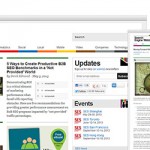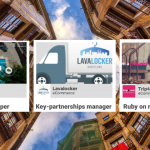This is the 5th part of a series of posts where Elliott shares his inside track on his experience of going through an incubator program. You can find the other editions here:
- Part I (Great Expectations)
- Part II (Back To School)
- Part III (Design Thinking)
- Part IV (Legal & Fundraising)
- Part VI (Pitching, Decks & Financials)
- Part VII (Demo Day & Last Days)
- Part VIII (The Round Up)
Hello again!
My name is Elliott, and I’m the co-founder and CEO of abroaden.
We’re an early-stage fintech based in Barcelona, creating the first wealth-building platform for people living abroad.
We’re currently participating in the F10 FinTech Incubator’s inaugural Barcelona batch.
My friends at Barcinno kindly invited me to guest-post our experience through this incredible program.
If you haven’t read my previous posts, you can check them out here.
With that, let’s dive into June’s theme: Sales and marketing.
Marketing is more important than you think.
Before going further into this post, I have a confession.
I used to be a marketer.
It gets worse.
I used to be a FinTech marketer.
But wait, there’s more.
I still am a FinTech marketer, even if I’m the co-founder and CEO of my company.
Here’s why.
Marketing will make or break a fintech company, especially a B2C one like ours.
In addition to being a hyper-competitive industry, it’s a sector focused on money.
Money is central to our lives (for better and for worse).
If we want to get people to trust us with their money, we not only have to get them to know that we exist but convince them that their hard-earned funds will be safe with us as well.
For FinTechs, that means spending a vast proportion of your budget on creating content, building brand awareness, cultivating trust, and, most crucially, engaging with your community.
What’s more, is that there are some highly-commoditized sectors in the FinTech space.
Today, it doesn’t take much from a tech and capital perspective to launch a neobank (or even a wealth management platform).
What takes tons of effort is getting users and differentiating yourself from your competition. To do so, you need an underserved niche, killer UX, and the ability to authentically reach and engage with your audience.
Marketing encompasses all of those activities.
As the CEO, I have to know my product and sell my vision to investors and intimately understand our marketing needs and what tactics we have at our disposal.
Of course, it helps tremendously to have a CMO as we do.
Still, many early-stage startup founders tend to neglect this part of their business as it’s not their expertise.
Thankfully for us in the program, F10 gave us an entire week dedicated to marketing, branding, and sales to make us masters in this all-important domain.
The state of marketing and why ads aren’t what they’re cracked up to be.
The week kicked off with an engaging presentation from Antonio Mas, a partner at Good Rebels digital advertising.
Through the session, he walked us through the current state of digital marketing and how best to approach this medium.
It shouldn’t come as a surprise that Google is the dominant force in this space.
He showed us examples of what works and what doesn’t on the search giant’s ad platforms.
More importantly, he stressed the importance of quality content and engagement (more on that below).
In the afternoon, our coach and incubator program head Vicente Muñoz ran a marketing strategy workshop.
Vicente has years of experience working with startups and founding companies.
Over this time, he’s developed an efficient system for early-stage startups to market their brand, vision, and first products.
The technique that he showed centered on the briefing model canvas from Lean.
This process focuses on identifying your user’s pain points and the communities and places where they congregate.
From there, you test messages and tactics in line with those parameters, using different mediums.
With the results, you repeat the process, measuring the results and iterating accordingly.
Marketing, after all, is as much science as it is art.
By measuring your results, you can refine your message, lowering your acquisition costs while building your audience.
Content counts
Between the morning and afternoon sessions, we were treated to a crash course in content marketing.
Presented by Clemens from Bourbon Creative and this publication, he ran through the basics of content and why it’s so important for startups.
In short, trust builds loyalty, which in turn generates paying customers.
Content is one of the best mediums to build trust as it’s the perfect forum to answer your target audience’s questions and build your brand authority.
Clemens went over the different types of content we should be creating and what purpose it can serve.
After detailing which strategies work for each medium, he provided us with a blueprint on how to bootstrap a content strategy as startup founders.
Like everything else in our lives, time management is vital.
However, if you play it right and use some nifty tools to help you, you can launch a minimum-viable content plan with as little as 10 hours a week worth of work.
Clemens also spoke about the importance of storytelling, but he was far from alone in preaching its virtues.
Nearly every presenter spoke of the importance of using a compelling narrative to build engagement.
Storytelling can quickly anchor ideas and complex topics into a reader’s mind, all in an instantly relatable context.
Storytelling doesn’t require a lot of complexity. In fact, for marketers, the simpler the story, the better.
What it does need to do is connect with whoever you’re targeting.
If you can do that, then your marketing strategy will pay off handsomely.
For B2C, your brand is the trust you build.
On Tuesday, we went over the all-important branding.
As a B2C company, we don’t have the luxury of a long funnel and deploying salespeople to close deals.
Instead, we have to rely on our brand, supporting content, and the trust it builds to convert users.
That means examining every aspect of our brand, including logos, colors, fonts, and tone of voice.
Our trainer that morning showed us numerous examples of some of the most recognizable brands and why their image made them market leaders.
For startups at our stage, getting branding right is challenging, if not perplexing.
With few exceptions, we founders are not designers but visionaries.
Yet, getting an identity correct is crucial if we’re going to fulfill our other marketing objectives.
After we got into F10, my co-founders and I decided that we’d spend the money to hire a professional to redo our logo, colors, and style.
I turned to my coworking space and found the talented Giuliano Rusciano.
Within a couple of short weeks, he gave us some beautiful proposals and then, with our feedback, produced the brand we’re using now.
From our end, this investment was entirely worth it as it gave us the foundation for all of our other marketing efforts.
As you can see:
Starting a B2B? Your funnel and network is more important than you think
Half of the startups in our batch are B2B.
If you’ve ever worked in a company selling to businesses, you’re well aware of how complex and drawn out those funnels can be.
That’s why we spent an entire day covering marketing to companies.
For us as abroaden, a B2C company, this workshop wasn’t so relevant.
However, my experience in FinTech marketing is on the B2B side, which, on a personal level, made passively following the workshop enjoyable.
The presenters for the day come from a “MarTech” startup based here in Barcelona.
The presentation ran us through the different sales funnel steps, including how to create a customer relationship management (CRM) tool.
Ideally, an idea-stage startup will want to have a couple of pilot customers signed once you have a minimum viable product up and running.
Your network will be the prime place to find those users.
Your funnel and the content you have in it will be even more crucial.
If you can leverage your existing contacts and your marketing assets (along with your amazing MVP), your startup’s chance of success increases tremendously.
Demo day dry run
On Thursday, we once again had a chance to meet with mentors and investors to bounce ideas off.
After gaining incredible feedback on our pitches, concepts, and tactics, we prepared for the evening’s highlight session: mock demo day.
Demo day is the cornerstone event of any incubator.
At the program’s end, all startups get to pitch in front of investors and industry professionals.
If all goes to plan, you get to begin conversations with the people and funds to take your company to the next level.
For F10, our format goes like this: each startup gets 3 minutes to pitch their company. Afterward, members of the audience have two minutes to ask questions.
Since this masterclass was the last one before the big day, we spent an entire afternoon rehearsing.
The pressure was intense.
Yes, we’ve practiced before, even in front of our peers.
Even the event simulation brought a level of nervous energy not yet felt by any of us.
The heat was even hotter, seeing as we had a special guest in the audience judging us.
Alper Rozanes, the co-founder of Slides35 Communications and an expert on public speaking, was there to rate and give feedback on all of our pitches.
His input, if blunt, was extraordinarily constructive.
It’s hard to understate how difficult pitching is, especially if you haven’t done it before.
Knowing that there will be more than 350 people in (virtual) attendance on demo day, getting as much feedback as we can right now is more important than ever.
Some fun in the sun
By Friday, everyone was exhausted.
On account of it being June and being in Barceloneta, F10 treated us to a team-building activity out at sea.
Later that morning, after a debriefing, we headed up the coast for some standup paddleboarding.
It’s important to remember that all of us in the incubator suffer from what’s known as “founder’s body,” which results from spending countless hours hammering out our ideas in front of a computer screen.
On the flip side, our diets are more or less meager, so it sort of works out.
Either way, it was a welcome hour with everyone outside, and somehow, repeatedly falling off a paddleboard is welcomingly refreshing.
The break was probably necessary.
Demo day was one short month away from the end of marketing week.
With 4YFN in the middle, time would quickly pass.
Before we knew it, demo day was here.
Stay tuned for the climatic finish to what’s been a whirlwind of a ride so far.











Leave a Reply